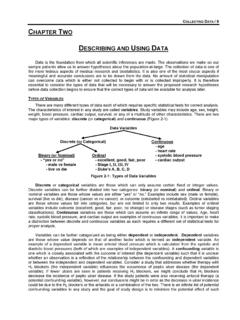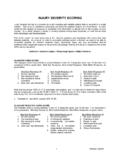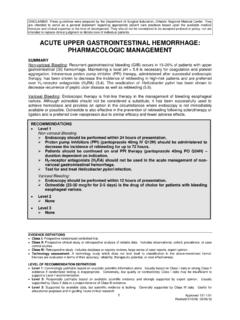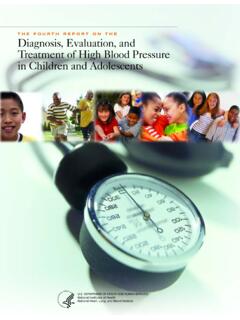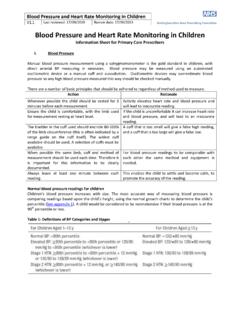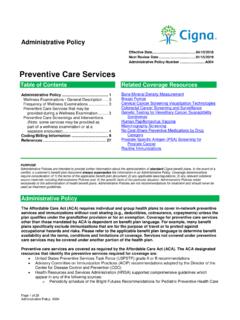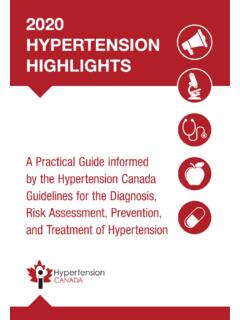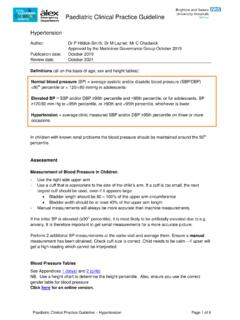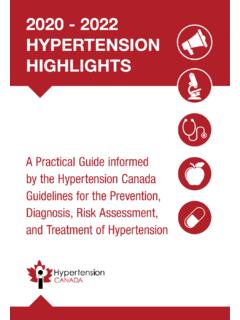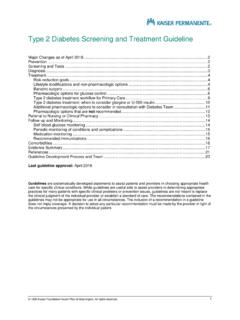Transcription of INTRA-ABDOMINAL PRESSURE MONITORING
1 DISCLAIMER: These guidelines were prepared by the Department of Surgical Education, Orlando Regional Medical Center. They are intended to serve as a general statement regarding appropriate patient care practices based upon the available medical literature and clinical expertise at the time of development. They should not be considered to be accepted protocol or policy, nor are intended to replace clinical judgment or dictate care of individual patients. EVIDENCE DEFINITIONS Class I: Prospective randomized controlled trial. Class II: Prospective clinical study or retrospective analysis of reliable data. Includes observational, cohort, prevalence, or case control studies. Class III: Retrospective study. Includes database or registry reviews, large series of case reports, expert opinion. Technology assessment: A technology study which does not lend itself to classification in the above-mentioned format.
2 Devices are evaluated in terms of their accuracy, reliability, therapeutic potential, or cost effectiveness. LEVEL OF RECOMMENDATION DEFINITIONS Level 1: Convincingly justifiable based on available scientific information alone. Usually based on Class I data or strong Class II evidence if randomized testing is inappropriate. Conversely, low quality or contradictory Class I data may be insufficient to support a Level I recommendation. Level 2: Reasonably justifiable based on available scientific evidence and strongly supported by expert opinion. Usually supported by Class II data or a preponderance of Class III evidence. Level 3: Supported by available data, but scientific evidence is lacking. Generally supported by Class III data. Useful for educational purposes and in guiding future clinical research.
3 1 Approved 5/18/04 Revised 2/21/08 INTRA-ABDOMINAL PRESSURE MONITORING SUMMARY Elevated INTRA-ABDOMINAL PRESSURE (IAP) is commonly encountered in the critically ill, has detrimental effects on all organ systems, and is associated with significant morbidity and mortality.
4 Serial IAP measurements are essential to the diagnosis , management, and fluid resuscitation of patients who develop INTRA-ABDOMINAL hypertension (IAH) and/or abdominal compartment syndrome (ACS). Intravesicular PRESSURE (IVP) is easily measured and should be monitored in all patients believed to be at risk for significant elevations in IAP. INTRODUCTION Elevated INTRA-ABDOMINAL PRESSURE (IAP) is frequently encountered among a variety of patient populations and causes significant morbidity and mortality (1-15). Increased recognition of its prevalence among the critically ill, combined with advances in both the diagnosis and management of INTRA-ABDOMINAL hypertension (IAH) and abdominal compartment syndrome (ACS), have resulted in significant improvements in patient survival (4,5).
5 IAP measurements are essential to the diagnosis and management of IAH/ACS. The World Society of the Abdominal Compartment Syndrome (WSACS) has recently published evidence-based medicine consensus guidelines for the measurement of IAP and treatment of IAH/ACS (1,2). RECOMMENDATIONS Level 1 None Level 2 Patients should be screened for IAH/ACS risk factors upon ICU admission and in the presence of new or progressive organ failure. If two or more risk factors for IAH/ACS are present, a baseline IAP measurement should be obtained. If IAH is present on baseline assessment, serial IAP measurements should be performed throughout the patient s critical illness. Level 3 IVP should be monitored using a closed technique.
6 IAP should be in mmHg (1 mmHg = cm H2O). IAP should be measured in the supine position, at end-expiration, with the transducer zeroed at the mid-axillary line, 30-60 seconds after instillation of no more than 25 mL of priming fluid (to allow bladder detrusor muscle relaxation), and in the absence of abdominal muscle contractions. 2 Approved 5/18/04 Revised 2/21/08 DEFINITIONS INTRA-ABDOMINAL PRESSURE (IAP) is the PRESSURE concealed within the abdominal cavity (1).
7 IAP increases with inspiration and decreases with expiration (16). It is directly affected by the volume of the solid organs or hollow viscera (which may be either empty or filled with air, liquid or fecal matter), the presence of ascites, blood or other space-occupying lesions (such as tumors or a gravid uterus), and the presence of conditions that limit expansion of the abdominal wall (such as burn eschars or third-space edema). Normal IAP is approximately 5-7 mmHg in the critically ill, but varies by disease severity with an IAP of 20-30 mmHg being common in patients with severe sepsis or an acute abdomen (1). An IAP in excess of 15 mmHg is associated with significant end-organ dysfunction and failure. Analogous to the widely accepted concept of cerebral perfusion PRESSURE , abdominal perfusion PRESSURE (APP), calculated as mean arterial PRESSURE (MAP) minus IAP, has been proposed as a more accurate predictor of visceral perfusion and an endpoint for resuscitation (1,2,17-19).
8 APP, by considering both arterial inflow (MAP) and restrictions to venous outflow (IAP), has been demonstrated to be statistically superior to MAP or IAP alone as well as to other common resuscitation endpoints such as arterial pH, base deficit, arterial lactate, and hourly urinary output in predicting survival from IAH/ACS (Figure 1). A target APP of 60 mmHg has been demonstrated to correlate with improved survival from IAH/ACS (2,19). INTRA-ABDOMINAL hypertension (IAH) is defined as a sustained or repeated pathologic elevation of IAP > 12 mmHg (1,2). IAH is graded as follows: Grade I IAP 12-15 mmHg Grade II IAP 16-20 mmHg Grade III IAP 21-25 mmHg Grade IV IAP > 25 mmHg. It should be noted that the IAP ranges associated with these grades have been revised downward in recent years as the detrimental impact of elevated IAP on end-organ function has been recognized.
9 Abdominal compartment syndrome (ACS) is defined as a sustained increase in IAP > 20 mmHg (with or without an APP < 60 mmHg) that is associated with new organ dysfunction / failure (1,2). The most common clinical findings are hypotension, refractory metabolic acidosis, persistent oliguria, elevated peak airway pressures, refractory hypercarbia, hypoxemia, and intracranial hypertension. ACS may be classified as primary (a condition associated with injury or disease in the abdomino-pelvic region that frequently requires early surgical or interventional radiological intervention), secondary (a condition that does not originate from the abdomino-pelvic region), or recurrent (a condition in which ACS redevelops following previous surgical or medical treatment of primary or secondary ACS) (1,2,8-12).
10 INCIDENCE Originally thought to be a disease solely of the traumatically injured, IAH and ACS have now been recognized to occur in a wide variety of patient populations (1-3,5,6,15). The reported incidences of IAH and ACS have varied significantly, however, due to the historical lack of a common nomenclature. Unrecognized, the mortality of IAH and ACS has been reported to be as high as 100%. Population IAH ACS Medical 18-78% 4-36% Surgical 32-43% 4-8% Trauma 2-50% Burn 37-70% 1-20% Pediatric **



